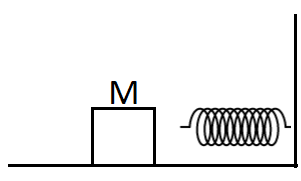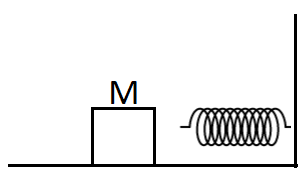
The block of mass M moving on the frictionless horizontal surface collides with the spring of spring constant K and compresses it by length L. The maximum moment of the block after collision is

(a) $\sqrt{MK}L$
(b) $\dfrac{K{{L}^{2}}}{2M}$
(c) Zero
(d) $\dfrac{M{{L}^{2}}}{K}$

Answer
581.4k+ views
Hint: We know the law of conservation of energy of the system i.e. $K.E+P.E=E\left( \text{constant} \right)$, where $\Delta K=\dfrac{1}{2}m{{v}^{2}}$ and $\Delta U=\dfrac{1}{2}k{{x}^{2}}$. So, using this law of conservation of energy of the system and formulas of kinetic energy and potential energy we will find the maximum moment of the block after collision.
Formula used: $K.E+P.E=E\left( \text{constant} \right)$, $\Delta K=\dfrac{1}{2}m{{v}^{2}}$, $\Delta U=\dfrac{1}{2}k{{x}^{2}}$
Complete step by step solution:
Now, as shown in the figure, the mass M mobbing on the frictionless surface collided with the spring and due to that the spring is compressed by length L. Now as spring compresses it releases also and due to that the moment is created on the block after collision and we have to find that moment.

Now, we know that the overall energy of the system also remains constant if the system is in the equilibrium. This law can be expressed mathematically as,
$K.E+P.E=E\left( \text{constant} \right)$ ……………(i)
Now, as the final energy of the system is constant, we will consider it as zero so the equation will be,
$K.E+P.E=0$
$\Rightarrow \Delta K+\Delta U=0$
$\Rightarrow \Delta K=-\Delta U$ …………(ii)
Now, we will consider the initial velocity of the block as v, so the kinetic energy is given by,
$\Delta K=\dfrac{1}{2}m{{v}^{2}}$ ……………..(iii)
Now, when the spring compresses the energy is stored in the spring in the form of potential energy and then when the block is released the potential energy gets converted into kinetic energy which is given by,
$\Delta U=\dfrac{1}{2}k{{x}^{2}}$ ………………….(iv)
Now, substituting the values of expression (iii) and (iv) in expression (ii) and replacing m with ‘M’ and k with ‘K’ we will get,
$\dfrac{1}{2}M{{v}^{2}}=-\dfrac{1}{2}K{{x}^{2}}$
Now, here the direction of mass after collision will be negative so the expression will be,
$\dfrac{1}{2}M{{v}^{2}}=-\left( -\dfrac{1}{2}K{{x}^{2}} \right)$
$\dfrac{1}{2}M{{v}^{2}}=\dfrac{1}{2}K{{x}^{2}}$ ………………(v)
Where x is the displacement or length of elongation or compression of spring from original position and K is spring constant.
Here, x will be the length of compression due to block which is ‘L’. so substituting L in expression (v) we will get,
$\dfrac{1}{2}M{{v}^{2}}=\dfrac{1}{2}K{{L}^{2}}$
Now, cancelling the common terms from the expression we will get,
$M{{v}^{2}}=K{{L}^{2}}$ …………………….(vi)
Now, we know that momentum is given by $p=mv$,
Where, m is mass and v is velocity.
Now, we will find the value of v from equation (vi) and substitute in expression of momentum,
${{v}^{2}}=\dfrac{K{{L}^{2}}}{M}$
$\Rightarrow v=\sqrt{\dfrac{K{{L}^{2}}}{M}}$
$\Rightarrow v=\sqrt{\dfrac{K}{M}}L$
Now, substituting value of v in expression of momentum we will get,
$p=M\sqrt{\dfrac{K}{M}}L$
On further simplifying we will get,
$\Rightarrow p=\sqrt{\dfrac{{{M}^{2}}K}{M}}L$
$\Rightarrow p=\sqrt{MK}L$.
Hence, the momentum of the block after collision is $p=\sqrt{MK}L$ as the mass of the given block is ‘M’ and the spring constant is ‘K’.
Thus, option (a) is correct.
Note: Here, in this question it is given that the surface is frictionless so we are neglecting the frictional force but students must read the question carefully, and if friction acts then solve it in that way. The mass of spring is also being neglected for simplicity but students should also know how to consider it if it is asked.
Formula used: $K.E+P.E=E\left( \text{constant} \right)$, $\Delta K=\dfrac{1}{2}m{{v}^{2}}$, $\Delta U=\dfrac{1}{2}k{{x}^{2}}$
Complete step by step solution:
Now, as shown in the figure, the mass M mobbing on the frictionless surface collided with the spring and due to that the spring is compressed by length L. Now as spring compresses it releases also and due to that the moment is created on the block after collision and we have to find that moment.

Now, we know that the overall energy of the system also remains constant if the system is in the equilibrium. This law can be expressed mathematically as,
$K.E+P.E=E\left( \text{constant} \right)$ ……………(i)
Now, as the final energy of the system is constant, we will consider it as zero so the equation will be,
$K.E+P.E=0$
$\Rightarrow \Delta K+\Delta U=0$
$\Rightarrow \Delta K=-\Delta U$ …………(ii)
Now, we will consider the initial velocity of the block as v, so the kinetic energy is given by,
$\Delta K=\dfrac{1}{2}m{{v}^{2}}$ ……………..(iii)
Now, when the spring compresses the energy is stored in the spring in the form of potential energy and then when the block is released the potential energy gets converted into kinetic energy which is given by,
$\Delta U=\dfrac{1}{2}k{{x}^{2}}$ ………………….(iv)
Now, substituting the values of expression (iii) and (iv) in expression (ii) and replacing m with ‘M’ and k with ‘K’ we will get,
$\dfrac{1}{2}M{{v}^{2}}=-\dfrac{1}{2}K{{x}^{2}}$
Now, here the direction of mass after collision will be negative so the expression will be,
$\dfrac{1}{2}M{{v}^{2}}=-\left( -\dfrac{1}{2}K{{x}^{2}} \right)$
$\dfrac{1}{2}M{{v}^{2}}=\dfrac{1}{2}K{{x}^{2}}$ ………………(v)
Where x is the displacement or length of elongation or compression of spring from original position and K is spring constant.
Here, x will be the length of compression due to block which is ‘L’. so substituting L in expression (v) we will get,
$\dfrac{1}{2}M{{v}^{2}}=\dfrac{1}{2}K{{L}^{2}}$
Now, cancelling the common terms from the expression we will get,
$M{{v}^{2}}=K{{L}^{2}}$ …………………….(vi)
Now, we know that momentum is given by $p=mv$,
Where, m is mass and v is velocity.
Now, we will find the value of v from equation (vi) and substitute in expression of momentum,
${{v}^{2}}=\dfrac{K{{L}^{2}}}{M}$
$\Rightarrow v=\sqrt{\dfrac{K{{L}^{2}}}{M}}$
$\Rightarrow v=\sqrt{\dfrac{K}{M}}L$
Now, substituting value of v in expression of momentum we will get,
$p=M\sqrt{\dfrac{K}{M}}L$
On further simplifying we will get,
$\Rightarrow p=\sqrt{\dfrac{{{M}^{2}}K}{M}}L$
$\Rightarrow p=\sqrt{MK}L$.
Hence, the momentum of the block after collision is $p=\sqrt{MK}L$ as the mass of the given block is ‘M’ and the spring constant is ‘K’.
Thus, option (a) is correct.
Note: Here, in this question it is given that the surface is frictionless so we are neglecting the frictional force but students must read the question carefully, and if friction acts then solve it in that way. The mass of spring is also being neglected for simplicity but students should also know how to consider it if it is asked.
Recently Updated Pages
Why are manures considered better than fertilizers class 11 biology CBSE

Find the coordinates of the midpoint of the line segment class 11 maths CBSE

Distinguish between static friction limiting friction class 11 physics CBSE

The Chairman of the constituent Assembly was A Jawaharlal class 11 social science CBSE

The first National Commission on Labour NCL submitted class 11 social science CBSE

Number of all subshell of n + l 7 is A 4 B 5 C 6 D class 11 chemistry CBSE

Trending doubts
What is meant by exothermic and endothermic reactions class 11 chemistry CBSE

10 examples of friction in our daily life

One Metric ton is equal to kg A 10000 B 1000 C 100 class 11 physics CBSE

1 Quintal is equal to a 110 kg b 10 kg c 100kg d 1000 class 11 physics CBSE

Difference Between Prokaryotic Cells and Eukaryotic Cells

What are Quantum numbers Explain the quantum number class 11 chemistry CBSE




